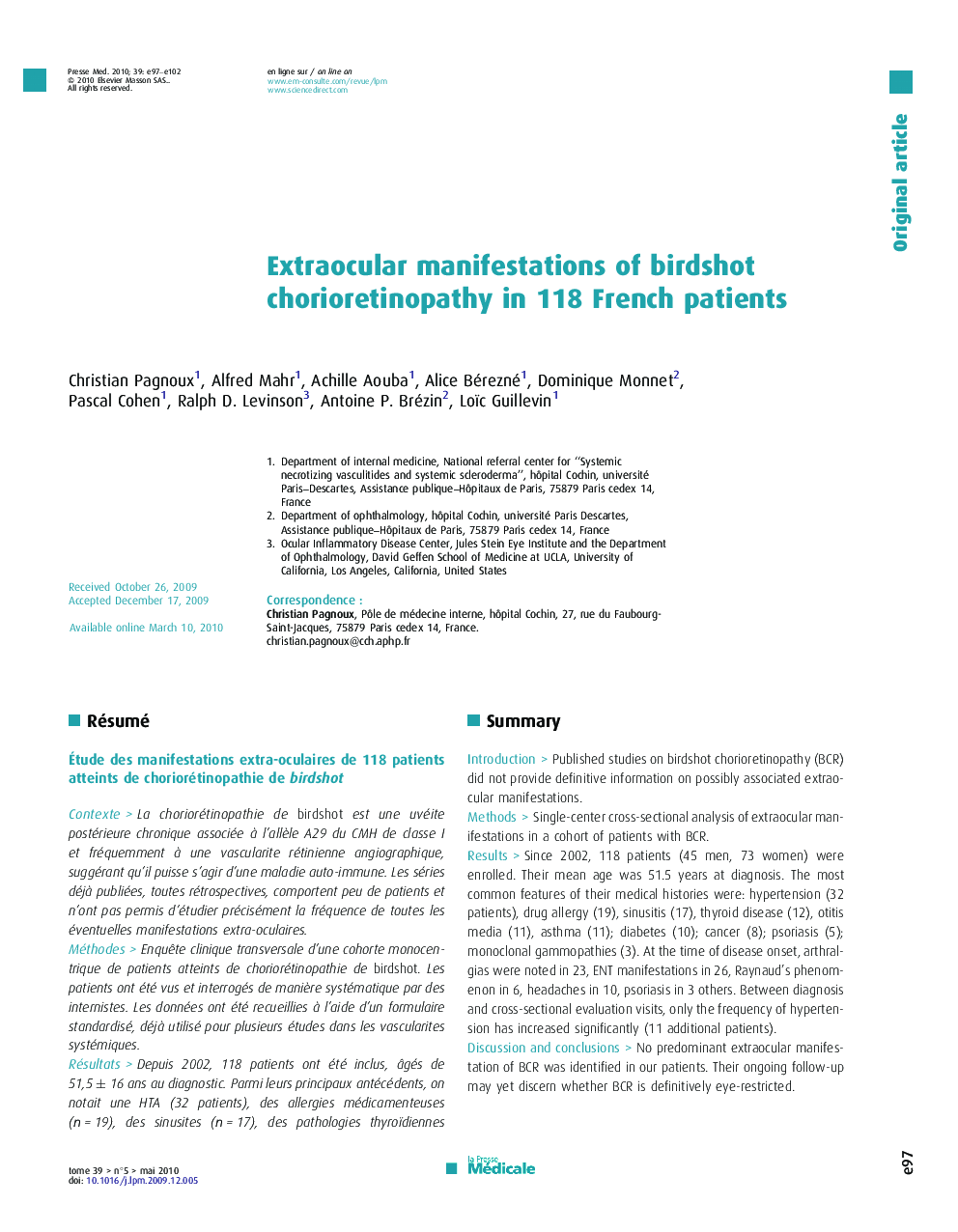| Article ID | Journal | Published Year | Pages | File Type |
|---|---|---|---|---|
| 3820522 | La Presse Médicale | 2010 | 6 Pages |
SummaryIntroductionPublished studies on birdshot chorioretinopathy (BCR) did not provide definitive information on possibly associated extraocular manifestations.MethodsSingle-center cross-sectional analysis of extraocular manifestations in a cohort of patients with BCR.ResultsSince 2002, 118 patients (45 men, 73 women) were enrolled. Their mean age was 51.5 years at diagnosis. The most common features of their medical histories were: hypertension (32 patients), drug allergy (19), sinusitis (17), thyroid disease (12), otitis media (11), asthma (11); diabetes (10); cancer (8); psoriasis (5); monoclonal gammopathies (3). At the time of disease onset, arthralgias were noted in 23, ENT manifestations in 26, Raynaud's phenomenon in 6, headaches in 10, psoriasis in 3 others. Between diagnosis and cross-sectional evaluation visits, only the frequency of hypertension has increased significantly (11 additional patients).Discussion and conclusionsNo predominant extraocular manifestation of BCR was identified in our patients. Their ongoing follow-up may yet discern whether BCR is definitively eye-restricted.
RésuméContexteLa choriorétinopathie de birdshot est une uvéite postérieure chronique associée à l’allèle A29 du CMH de classe I et fréquemment à une vascularite rétinienne angiographique, suggérant qu’il puisse s’agir d’une maladie auto-immune. Les séries déjà publiées, toutes rétrospectives, comportent peu de patients et n’ont pas permis d’étudier précisément la fréquence de toutes les éventuelles manifestations extra-oculaires.MéthodesEnquête clinique transversale d’une cohorte monocentrique de patients atteints de choriorétinopathie de birdshot. Les patients ont été vus et interrogés de manière systématique par des internistes. Les données ont été recueillies à l’aide d’un formulaire standardisé, déjà utilisé pour plusieurs études dans les vascularites systémiques.RésultatsDepuis 2002, 118 patients ont été inclus, âgés de 51,5 ± 16 ans au diagnostic. Parmi leurs principaux antécédents, on notait une HTA (32 patients), des allergies médicamenteuses (n = 19), des sinusites (n = 17), des pathologies thyroïdiennes (n = 12), des otites moyennes (n = 11), un asthme (n = 11), un diabète (n = 10), un cancer (8), un psoriasis (5) et/ou une gammapathie monoclonale (3). Au début de la maladie, 23 patients avaient des arthralgies, 26 des manifestations ORL, notamment une baisse d’acuité auditive (n = 8) et 6 un syndrome de Raynaud. Entre le diagnostic et la visite d’évaluation, 11 patients supplémentaires avaient une HTA, en majorité liée à la prise de ciclosporine.Discussion et conclusionsLa fréquence des manifestations extra-oculaires au cours de la choriorétinopathie de birdshot ne paraît pas plus importante que dans la population générale. Le suivi de cette cohorte permettra de confirmer s’il s’agit bien d’une pathologie ophtalmologique limitée.What is already known•The cause of birdshot chorioretinopathy remains unknown.•Environmental factors, genetic and immunological predisposition might be involved.•Published studies on birdshot chorioretinopathy did not provide definitive information on possibly associated extraocular manifestations, that would suggest a more general immunological, and in particular auto-immune, disorder.What this article adds•While exposure to tobacco, history of hypertension, psoriatic lesions and/or auditory manifestations, especially tinnitus and hearing loss, may appear intriguingly common in our patients, their exact frequencies do not strikingly differ from those reported in the French general population.•Hence, our results support that BCR is definitively an eye-restricted disease.
